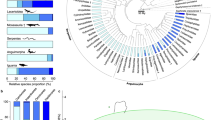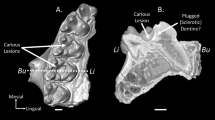Abstract
The study of mammalian evolution depends greatly on understanding the evolution of teeth and the relationship of tooth shape to diet. Links between gross tooth shape, function and diet have been proposed since antiquity, stretching from Aristotle1 to Cuvier2, Owen3 and Osborn4. So far, however, the possibilities for exhaustive, quantitative comparisons between greatly different tooth shapes have been limited. Cat teeth and mouse teeth, for example, are fundamentally distinct in shape and structure as a result of independent evolutionary change over tens of millions of years5. There is difficulty in establishing homology between their tooth components or in summarizing their tooth shapes, yet both carnivorans and rodents possess a comparable spectrum of dietary specializations from animals to plants. Here we introduce homology-free techniques6,7,8 to measure the phenotypic complexity of the three-dimensional shape of tooth crowns. In our geographic information systems (GIS) analysis of 441 teeth from 81 species of carnivorans and rodents, we show that the surface complexity of tooth crowns directly reflects the foods they consume. Moreover, the absolute values of dental complexity for individual dietary classes correspond between carnivorans and rodents, illustrating a high-level similarity between overall tooth shapes despite a lack of low-level similarity of specific tooth components. These results suggest that scale-independent forces have determined the high-level dental shape in lineages that are widely divergent in size, ecology and life history. This link between diet and phenotype will be useful for inferring the ecology of extinct species and illustrates the potential of fast-throughput, high-level analysis of the phenotype.
This is a preview of subscription content, access via your institution
Access options
Subscribe to this journal
Receive 51 print issues and online access
$199.00 per year
only $3.90 per issue
Buy this article
- Purchase on Springer Link
- Instant access to full article PDF
Prices may be subject to local taxes which are calculated during checkout


Similar content being viewed by others
References
Aristotle. Parts of Animals (transl. Peck, A. L.) (Harvard Univ. Press, Cambridge, Massachusetts, 1983)
Cuvier, G. Discours sur les Révolutions de la Surface du Globe, et sur les Changements qu’elles ont Produits dans le Règne Animal (Dufour et d’Ocagne, Paris, 1825)
Owen, R. Odontography (Hippolyte Baillière, London, 1840–1845.)
Osborn, H. F. Evolution of Mammalian Teeth, to and from the Triangular Type (Macmillan, New York, 1907)
Wible, J. R., Rougier, G. R. & Novacek, M. J. in The Rise of Placental Mammals: Origins and Relationships of the Major Extant Clades (eds Rose, K. D. & Archibald, J. D.) 15–36 (Johns Hopkins Univ. Press, Baltimore, Maryland, 2005)
Ungar, P. S. & M’Kirera, F. A solution to the worn tooth conundrum in primate functional anatomy. Proc. Natl Acad. Sci. USA 100, 3874–3877 (2003)
Evans, A. R. Connecting morphology, function and tooth wear in microchiropterans. Biol. J. Linn. Soc. 85, 81–96 (2005)
King, S. J. et al. Dental senescence in a long-lived primate links infant survival to rainfall. Proc. Natl Acad. Sci. USA 102, 16579–16583 (2005)
Fortelius, M. in Teeth Revisited: Proceedings of the VIIth International Symposium on Dental Morphology (eds Russell, D. E., Santoro, J.-P. & Sigogneau-Russell, D.) 459–462 (Mémoires du Muséum national d’Histoire naturelle C, Paris, 1988)
Lucas, P. W. Dental Functional Morphology (Cambridge Univ. Press, Cambridge, 2004)
Evans, A. R. & Sanson, G. D. The tooth of perfection: functional and spatial constraints on mammalian tooth shape. Biol. J. Linn. Soc. 78, 173–191 (2003)
Stevens, C. & Hume, I. Comparative Physiology of the Vertebrate Digestive System (Cambridge Univ. Press, Cambridge, 1995)
Kay, R. F. The functional adaptations of primate molar teeth. Am. J. Phys. Anthropol. 43, 195–215 (1975)
Strait, S. G. Differences in occlusal morphology and molar size in frugivores and faunivores. J. Hum. Evol. 25, 471–484 (1993)
Hillson, S. Teeth (Cambridge Univ. Press, Cambridge, 2005)
Peyer, B. Comparative Odontology (Univ. of Chicago Press, Chicago, Illinois, 1968)
Polly, P. D. On morphological clocks and paleophylogeography: towards a timescale for Sorex hybrid zones. Genetica 112, 339–357 (2001)
Polly, P. D., Le Comber, S. C. & Burland, T. M. On the occlusal fit of tribosphenic molars: Are we underestimating species diversity in the Mesozoic? J. Mamm. Evol. 12, 283–299 (2005)
Birdsey, G. M. et al. A comparative analysis of the evolutionary relationship between diet and enzyme targeting in bats, marsupials and other mammals. Proc. R. Soc. B 272, 833–840 (2005)
Phillips, C. J., Weiss, A. & Tandler, B. Plasticity and patterns of evolution in mammalian salivary glands: comparative immunohistochemistry of lysozyme in bats. Eur. J. Morphol. 36, 19–26 (1998)
Kurtén, B. The evolution of the polar bear, Ursus maritimus Phipps. Acta Zool. Fenn. 108, 1–30 (1964)
Kurtén, B. Pleistocene Mammals of Europe (Weidenfeld & Nicolson, London, 1968)
Talbot, S. L. & Shields, G. F. Phylogeography of brown bears (Ursus arctos) of Alaska and paraphyly within the Ursidae. Mol. Phylogenet. Evol. 5, 477–494 (1996)
Kangas, A. T., Evans, A. R., Thesleff, I. & Jernvall, J. Nonindependence of mammalian dental characters. Nature 432, 211–214 (2004)
Scott, R. S. et al. Dental microwear texture analysis shows within-species diet variability in fossil hominins. Nature 436, 693–695 (2005)
Nowak, R. Walker’s Mammals of the World (Johns Hopkins Univ. Press, Baltimore, Maryland, 1999)
Shannon, C. E. A mathematical theory of communication. Bell Syst. Tech. J. 27, 379–423. 623–656 (1948)
Eterovick, P. C., Figueira, J. E. C. & Vasconcellos-Neto, J. Cryptic coloration and choice of escape microhabitats by grasshoppers (Orthoptera: Acrididae). Biol. J. Linn. Soc. 61, 485–499 (1997)
Cover, T. M. & Thomas, J. A. Elements of Information Theory (Wiley, New York, 1991)
Acknowledgements
We thank G. Evans, K. Kavanagh, I. Salazar Ciudad, P. Wright, C. Strömberg, A. Gionis, G. Sanson, A. Lister, M. Skinner, I. Pljusnin and J. Eronen for comments and discussions on this work; E. Penttilä for scanning some of the rodents; M. Barbeitos for the suggestion to use information theory; and the following museum curators, collection managers and librarians for loans and reference material: O. Grönwall, R. Asher, M. Hildén, I. Hanski, K. Gully and M. Cytrynbaum. This study was supported by the Academy of Finland (J.J., M.F.), Synthesys (A.R.E.), the Centre for International Mobility (CIMO) (A.R.E.), and a National Science Foundation Postdoctoral Fellowship (G.P.W.).
Author information
Authors and Affiliations
Corresponding author
Ethics declarations
Competing interests
Data deposition: the three-dimensional scans for this study are deposited in the MorphoBrowser database (http://morphobrowser.biocenter.helsinki.fi/). Reprints and permissions information is available at www.nature.com/reprints. The authors declare no competing financial interests.
Supplementary information
Supplementary Information
The file contains Supplementary Figures and Legends 1-2 and Supplementary Tables 1-8. Supplementary Figures show orientation patch count (OPC) versus two different measures of relative tooth size. Supplementary Tables list the species used in the study together with dietary information and references; data for some of the dental complexity measures; and the full results of statistical tests mentioned in the paper. (PDF 244 kb)
Rights and permissions
About this article
Cite this article
Evans, A., Wilson, G., Fortelius, M. et al. High-level similarity of dentitions in carnivorans and rodents. Nature 445, 78–81 (2007). https://doi.org/10.1038/nature05433
Received:
Accepted:
Published:
Issue Date:
DOI: https://doi.org/10.1038/nature05433
This article is cited by
-
Comparison of dental topography of marmosets and tamarins (Callitrichidae) to other platyrrhine primates using a novel freeware pipeline
Journal of Mammalian Evolution (2024)
-
Morphological and radiological mapping of dental cusps in relation to spatial constraints on tooth shape of one-humped camel (Camelus dromedarius)
Zoological Letters (2023)
-
Phylogenetic congruence, conflict and consilience between molecular and morphological data
BMC Ecology and Evolution (2023)
-
Form, function, and tissue proportions of the mustelid carnassial molar
Mammal Research (2023)
-
Quantifying mammalian diets
Mammalian Biology (2023)
Comments
By submitting a comment you agree to abide by our Terms and Community Guidelines. If you find something abusive or that does not comply with our terms or guidelines please flag it as inappropriate.



